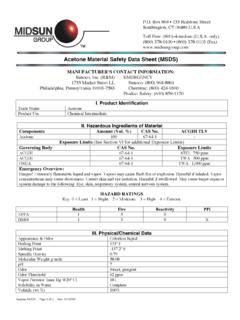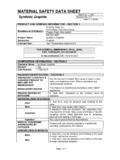Transcription of MATERIAL SAFETY DATA SHEET - Stern and Stern
1 MATERIAL SAFETY data SHEET . 1. Product and Company Identification MATERIAL name Nylon 6,6 Fiber Version # Issue date May-29-2015. Revision date 29-May-2015. MSDS Number 46264. Manufacturer Company Information INVISTA (Canada) Company 455 Front Road Kingston, Ontario, K7L4Z6. Emergency telephone: CANUTEC: 1-855-521-5687. INVISTA ERAP (24 Hour): 613-348-3616. General Information 1-770-792-4221. e-mail 2. Hazards Identification Emergency overview WARNING. Product may form explosive dust/air mixtures if high concentration of product dust is suspended in air. This product is supplied as a fiber. When the fiber products are cut, chopped, or manipulated in other similar handling methods, some dust may be produced. Exposure to powder or dusts may be irritating to eyes, nose and throat.
2 Potential health effects Routes of exposure Inhalation. Skin contact. Eye contact. Ingestion. Eyes Particles and dusts may be mechanically irritating when in contact with eyes. Symptoms include itching, burning, redness and tearing. Skin Particles and dusts may be mechanically irritating to skin. While irritation is not expected under normal use, prolonged exposure and continuous rubbing of fiber particles on skin may produce skin irritation. Symptoms of mechanical irritation may include redness and/or itching. Inhalation Dusts of this product may cause irritation of the nose, throat, and respiratory tract. Inhalation of dust may cause shortness of breath, tightness of the chest, a sore throat and cough. Ingestion Ingestion of large amounts of fibers may cause gastrointestinal blockage which can cause stomach distress.
3 Chronic effects Not expected to occur. Potential environmental effects None known. 3. Composition / Information on Ingredients Components CAS # Concentration NYLON 66 POLYMER 32131-17-2 90 - 99 %. CARBON BLACK 1333-86-4 ; , 1-5%. FIBER FINISH Mixture ; , 1-2%. PIGMENTS Mixture ; , 1-3%. TITANIUM DIOXIDE 13463-67-7 ; , 1-5%. Composition comments This fiber may have been produced with carbon black and/or titanium dioxide. These compounds, as present in this MATERIAL , are not water soluble and are encapsulated in the polymer. They are not extracted or released in normal processing and handling. Therefore these compounds are not expected to present a hazard in normal handling, processing, use and disposal. MATERIAL name: Nylon 6,6 Fiber MSDS #: 46264 MSDS CANADA.
4 Original date: 29-May-2015 Issue date: 29-May-2015 1/6. 4. First Aid Measures First aid procedures Eye contact Rinse immediately with plenty of water, also under the eyelids. If irritation persists get medical attention. Skin contact Product, at ambient conditions, is not expected to be hazardous by skin contact. Should irritation occur, rinse with water. Inhalation If exposed to excessive levels of dusts or fumes, remove to fresh air and get medical attention if cough or other symptoms develop. If breathing is difficult, give oxygen. Ingestion If swallowed, do NOT induce vomiting. If vomiting occurs naturally, have victim lean forward to reduce risk of aspiration. Rinse mouth. Never give anything by mouth to a victim who is unconscious or is having convulsions.
5 Consult a physician if necessary. Notes to physician Provide general supportive measures and treat symptomatically. General advice Ensure that medical personnel are aware of the MATERIAL (s) involved, and take precautions to protect themselves. 5. Fire Fighting Measures Flammable properties Dusts at sufficient concentrations can form explosive mixtures with air. Extinguishing media Suitable extinguishing Dry chemical, CO2, water spray or regular foam. media Apply extinguishing media carefully to avoid creating airborne dust. Unsuitable extinguishing Do not use a solid water stream as it may scatter and spread fire. media Protection of firefighters Specific hazards arising Upon decomposition, this product may yield oxides of nitrogen and ammonia, carbon dioxide, from the chemical carbon monoxide and other low molecular weight hydrocarbons.
6 Traces of hydrogen cyanide may be found in fire conditions. Explosion hazard: Avoid generating dust; fine dust dispersed in air in sufficient concentrations and in the presence of an ignition source is a potential dust explosion hazard. Protective equipment for Wear full protective clothing, including helmet, self-contained positive pressure or pressure firefighters demand breathing apparatus, protective clothing and face mask. Fire fighting Use standard firefighting procedures and consider the hazards of other involved materials. equipment/instructions Explosion data Sensitivity to static Not expected to be shock sensitive. discharge Sensitivity to mechanical None known. impact Hazardous combustion Upon decomposition, this product may yield oxides of nitrogen and ammonia, carbon dioxide, products carbon monoxide and other low molecular weight hydrocarbons.
7 Traces of hydrogen cyanide may be found in fire conditions. 6. Accidental Release Measures Personal precautions Keep unnecessary personnel away. Use personal protective equipment. Environmental precautions Prevent further leakage or spillage if safe to do so. Methods for cleaning up Clean up in accordance with all applicable regulations. Eliminate all ignition sources if safe to do so. Use only non-sparking tools. Large Spills: Sweep up and shovel into suitable containers for disposal. Avoid dispersal of dust in air. If sweeping of a contaminated area is necessary use a dust suppressant agent which does not react with the product. Dust deposits should not be allowed to accumulate on surfaces, as these may form an explosive mixture if they are released into the atmosphere in sufficient concentration.
8 Small Spills: Sweep up or gather MATERIAL and place in appropriate container. Never return spills to original containers for re-use. Other information None known. MATERIAL name: Nylon 6,6 Fiber MSDS #: 46264 MSDS CANADA. Original date: 29-May-2015 Issue date: 29-May-2015 2/6. 7. Handling and Storage Handling Use care in handling/storage. When fiber products are cut, chopped, or manipulated in other similar handling methods, some dust may be produced. Use good housekeeping methods to keep accumulation of dust to a minimum. Minimize dust generation and accumulation. Do not breathe dust from this MATERIAL . Combustible dust clouds may be created where operations produce fine MATERIAL (dust). Avoid significant deposits of MATERIAL , especially on horizontal surfaces, which may become airborne and form combustible dust clouds and may contribute to secondary explosions.
9 Handling and processing operations should be conducted in accordance with best practices' ( NFPA-654). Take measures to prevent the build up of electrostatic charge. Storage Keep the container tightly closed and dry. To maintain product quality, do not store in heat or direct sunlight. Keep from freezing. Routine housekeeping should be instituted to ensure that dusts do not accumulate on surfaces. Keep in a well-ventilated place. Guard against dust accumulation of this MATERIAL . Dry powders can build static electricity charges when subjected to the friction of transfer and mixing operations. Provide adequate precautions, such as electrical grounding and bonding, or inert atmospheres. 8. Exposure Controls / Personal Protection Occupational exposure limits No exposure limits noted for ingredient(s).
10 Engineering controls Keep formation of airborne dusts to a minimum. Ventilation should be sufficient to effectively remove and prevent buildup of any dusts or fumes that may be generated during handling or thermal processing. It is recommended that all dust control equipment such as local exhaust ventilation and MATERIAL transport systems involved in handling of this product contain explosion relief vents or an explosion suppression system or an oxygen-deficient environment. Ensure that dust-handling systems (such as exhaust ducts, dust collectors, vessels, and processing equipment) are designed in a manner to prevent the escape of dust into the work area ( , there is no leakage from the equipment). Use only appropriately classified electrical equipment and powered industrial trucks.







